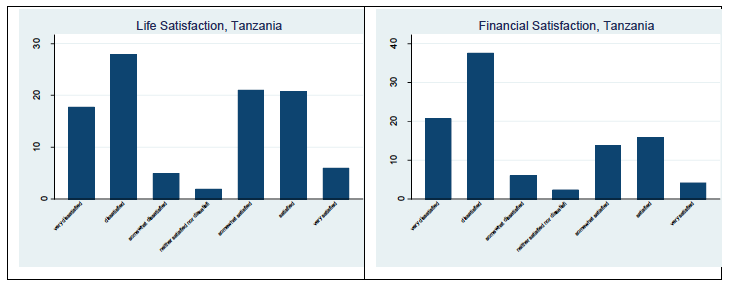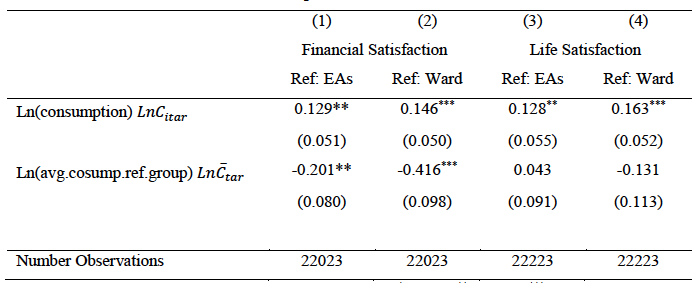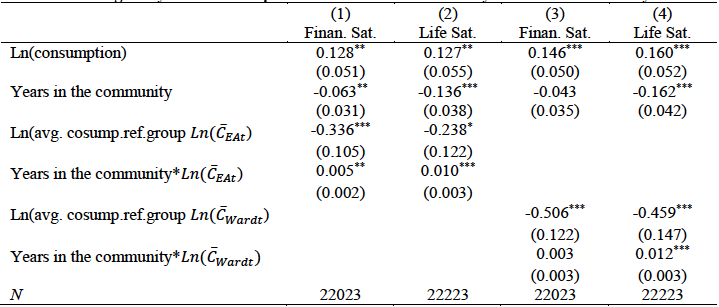In their BSE Working Paper (No. 1124), “Relative Deprivation in Tanzania”, Jean-Marc Bédhat Atsebi and Ada Ferrer-i-Carbonell explore relative concern for the Tanzanian population’s satisfaction with their own life and financial situation. Using a novel empirical approach in the African countries literature, the authors find strong evidence of relative deprivation in financial satisfaction of all individuals in Tanzania, while the evidence for life satisfaction is only for individuals with weaker ties with their community. In contrast with most of the current literature, the authors argue that this positive effect is due to feelings of empathy.
Novel data and comparison measurements
To study the importance of relative deprivation in Tanzania the authors make use of two measures of satisfaction, life and financial. They argue that these two satisfaction measures represent two different proxies for utility and thus they can bring different results that in turn might help to understand the mechanisms behind relative concerns. In fact, the paper is the first to use a financial content measure and thus it introduces a new finding of relative deprivation in a poor context in terms of financial and not life satisfaction.
Moreover, the authors use two specifications of reference group defined by two different geographical areas, which enables them to examine how results change if the reference group includes only close neighbours or individuals living further away.
The paper explores the Tanzania National Panel Survey (TNPS), a representative household survey implemented by the National Bureau of Statistics of Tanzania and the World Bank. The data has a panel structure and three (out of four available) waves are used: 2008/2009; 2010/2011; 2012/13. The panel data is also a contribution to the earlier literature and the paper is a pioneer on controlling for individual fixed in the context of relative deprivation in Africa. The self-reported satisfaction literature has showed that the exclusion of this time persistent unobservable individual characteristics biases the results and so authors argue that its inclusion is crucial.
The empirical strategy adopted in the paper uses self-reported satisfaction questions. Individuals were asked to value on a finite scale -from very satisfied (1) to very dissatisfied (7)- their satisfaction level with their own life and financial situation. With these satisfaction measures in hand, the authors estimate utility level of a certain individual in a given year and geographic location.
The main purpose of the present study is to analyze the effects of individual consumption and average consumption of the reference group on individual life and financial satisfaction. In the estimation, the authors control for individual and household characteristics as well as location variables, and individual, regional and time fixed effects.
The reality in Tanzania
Tanzania is the 30th poorest country in the world (among the 14% poorest countries), according to the World Bank. The National Bureau of Statistics of Tanzania has estimated an increase in the incidence of poverty in the country, mostly in rural areas. According to the World Happiness Report, the Tanzania is the fourth unhappiest country in the world. In a sense then, the paper studies the feelings of relative deprivation for own life and financial satisfaction in a setting of a poor and unsatisfied country.
On exploring the panel data, the authors find an average life satisfaction of 3.67 and 3.14 for financial satisfaction. Figure 1 shows the distribution of these measurements.

The distribution of the answer to the life and financial satisfaction question for the paper sample is fairly polarized, especially for life satisfaction; and financial satisfaction is skewed to the left. This evidence is in contrast with most western countries, where life satisfaction is skewed to the right and its distribution is not polarized.
Heterogenous effects of relative deprivation
The paper finds evidence of relative concerns on financial satisfaction of all individuals in Tanzania, regardless of the definition of the reference group, whether the individual lives in a rural or urban environment, and quite independently of the number of years in the community (proxying for the strength of the ties with the reference group). This result contradicts the current literature that argues that the positive effect often found in rural poor setting of average consumption on life satisfaction is due to richer neighbors acting as an informal insurance in times of hardship. If this would be true, one would expect to find the positive effect also on financial satisfaction. Table 1 presents these results.

Standard errors in parentheses clustered either at EAs or Wards. * p < 0.1, ** p < 0.05, *** p < 0.01. Regressions include the long set of controls, and district and time fixed effects. Errors are cluster at the enumeration area (specifications 1 and 3) and ward level (specification 2 and 4). The long tables are available upon request.
Own consumption positively correlates with financial and life satisfaction, with statically significant coefficients. On the other hand, financial satisfaction is negatively (and statistically significant) correlated with the average consumption of their reference group, regardless of the definition the reference group – “EAs” and “wards” for smaller and larger geographical level, respectively. The negative coefficient of the reference consumption however is twice as large when the reference group is defined as the ward. Average consumption of reference group estimates for life satisfaction are not precise due to heterogeneous effects, as shown below.
Life satisfaction estimation results are heterogenous. Interestingly, the authors find a positive effect of average consumption of the reference depending on the strength of the ties that individuals have with their reference group. Table 2 reports these results.

Standard errors in parentheses clustered either at EAs or Wards; * p < 0.1, ** p < 0.05, *** p < 0.01. Regressions include the long set of controls, district and time fixed effects.
All the coefficients of the average consumption of the reference group are negative, both for financial and life satisfaction and regardless of the definition of the reference group. Nevertheless, its interaction with the number of years in the community turns the coefficient to positive for some sub-samples. For individuals with strong ties (47% of the total sample; 54% of the rural sample) there is a positive correlation between life satisfaction and the average consumption of close neighbours. Therefore, the authors argue that the positive effect is explained by feelings of empathy towards those with whom one has strong ties.
In sum, the paper shows that all individuals in Tanzania exhibit relative concerns in terms of financial satisfaction regardless of how we define the reference group. This result is new in the literature and shows that individuals in a poor setting also show feelings of relative deprivation in terms of their financial satisfaction. This results contradicts current findings that argue that in very poor and rural settings individuals experience positive externalities of having rich neighbors who can help in times of hardship. For life satisfaction instead, and in line with the current literature, relative concerns show important heterogeneity and results support authors’ argument that the positive coefficient of average income of close neighbors runs through empathy and therefore depend on the strength of the ties between members of the same community.


